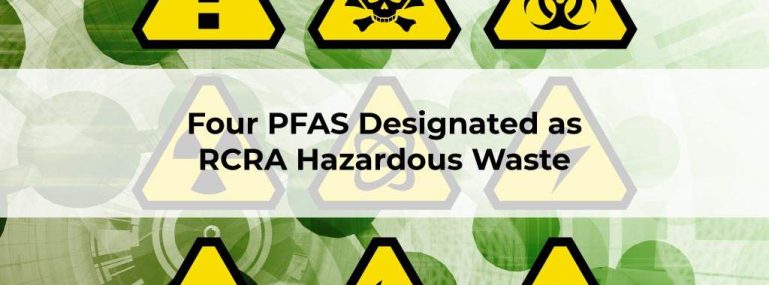On October 26, 2021, the U.S. EPA announced that it would initiate two rulemakings to address PFAS contamination across the country. In the first rulemaking, four of the so-called “forever chemicals” will be designated as hazardous wastes under the Resource Conservation and Recovery Act (RCRA). Solid wastes, such as garbage and sludge from water treatment plants, wastewater treatment plants, or pollution control facilities, and other discarded material, result from industrial, commercial, mining, agricultural, and community activities, are regulated by RCRA. Solid wastes are not limited to waste that is physically solid.
Here are the four PFAS that will be subject to this rulemaking:
- Perfluorooctanoic acid (PFOA)- found in stain-resistant carpet, water-repellent clothes, paper and cardboard packaging, ski wax, and foams used to fighting fire
- Perfluorooctane sulfonic acid (PFOS)- found in leather, pesticides, firefighting foams, polishes, adhesives, paint
- Perfluorobutane sulfonic acid (PFBS)- found in environmental media and consumer products, including surface water, wastewater, drinking water, dust, carpeting and carpet cleaners, and floor wax
- Hexafluoropropylene oxide (HFPO) dimer acid and its ammonium salt – more commonly known as GenX- versatile fluorointermediate, used in the synthesis of fluoromonomers and fluoropolymers and lubricants.
The announcement was made on the same day that the EPA released its latest evaluation of the toxicity of GenX. Among these four PFAS, GenX is considered the most toxic. GeneX is commonly used in nonstick coatings such as Teflon™, as a processing aid in fluoropolymer plastics. A review of the 2016 toxicity assessments for PFOA and PFOS will be done by the EPA.
It will clarify EPA’s authority to conduct investigations and clean up for wastes that meet RCRA’s definition of PFAS. Through the RCRA corrective action process, EPA has set its goal to provide a clear view that emerging contaminants, such as PFAS, can be cleaned up. RCRA’s Regulation of PFAS, as well as other emerging contaminants, has broad implications.
The Environmental Response, Compensation, and Liability Act of 1980 (CERCLA) automatically lists hazardous wastes as hazardous substances by virtue of the Resource Conservation and Recovery Act of 1976 (RCRA). It is likely that existing Superfund sites will need to address PFAS contamination, which could result in the identification of new potential responsible parties. The EPA has not yet determined how it will deal with the closed sites that may contain PFAS.
These rulemakings are responses to the petition from the Governor of New Mexico. By addressing PFAS contamination across the nation, they are building on EPA’s broader action plan. EPA has published a PFAS Strategic Roadmap. PFAS contamination is addressed in an integrated manner through 2024. The EPA needs to provide better guidance on disposal and destruction of PFAS to stakeholders. In accordance with the EPA’s Roadmap, the decision is expected to be made during the next year.
Learn more about how these new additions to RCRA Hazardous Waste affect your compliance status, talk to one of our global compliance experts.





